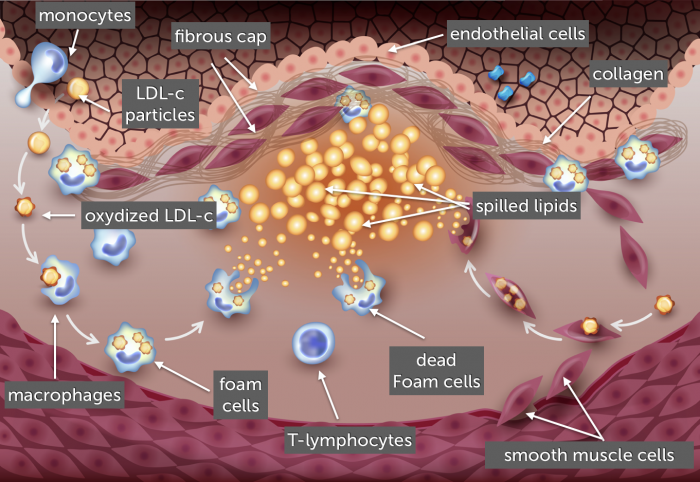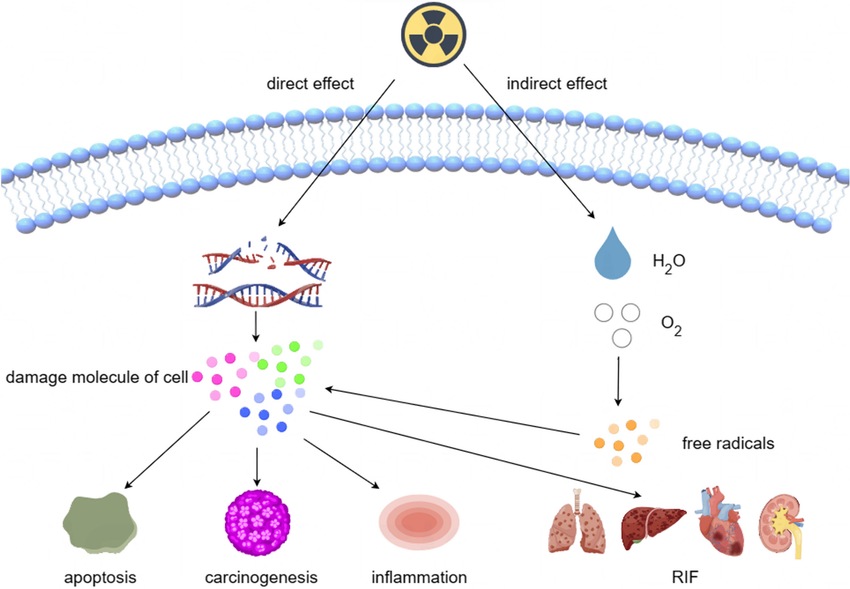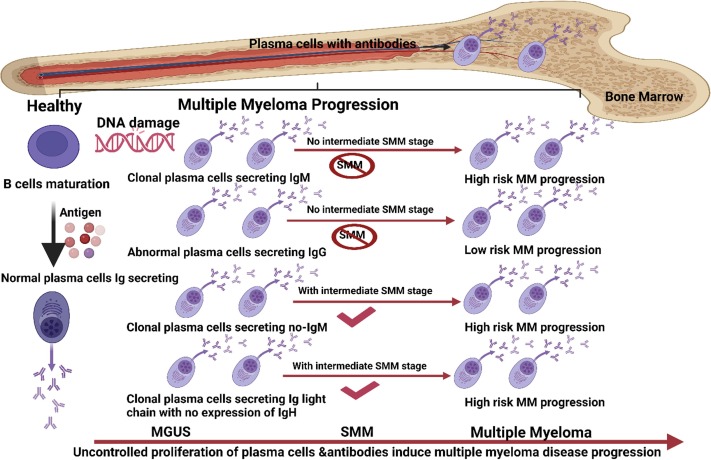
Morphology and Distribution of Atherosclerotic Plaque
1. Morphology of Atherosclerotic Plaque
Atherosclerotic plaques exhibit a complex morphology characterized by several key features that contribute to their stability or vulnerability. The primary components of these plaques include lipids, inflammatory cells, smooth muscle cells, and extracellular matrix.
- Lipid Core: At the center of a vulnerable plaque is a large lipid core composed mainly of cholesterol esters and other lipids. This core is formed from the accumulation of low-density lipoprotein (LDL) particles that have undergone oxidation, leading to the formation of oxidized LDL (ox-LDL). The presence of a large lipid core is associated with an increased risk of plaque rupture.
- Fibrous Cap: Surrounding the lipid core is a fibrous cap made up of smooth muscle cells and extracellular matrix proteins such as collagen. The thickness and integrity of this cap are critical determinants of plaque stability. A thin fibrous cap is more prone to rupture, which can lead to thrombosis and subsequent cardiovascular events.
- Inflammatory Cells: Inflammatory cells, particularly macrophages and T-lymphocytes, infiltrate the plaque. Macrophages play a dual role; they can contribute to plaque stability by clearing debris but also promote instability through the secretion of pro-inflammatory cytokines and enzymes that degrade the extracellular matrix.
- Neovascularization: Vulnerable plaques often exhibit neovascularization, characterized by the formation of new blood vessels within the plaque. These immature vessels are prone to leakage and can contribute to intraplaque hemorrhage (IPH), further destabilizing the plaque.
- Calcification: Over time, some plaques may undergo calcification, which can be seen as areas of mineral deposition within the plaque structure. While calcification may stabilize certain plaques, it can also indicate advanced disease.
2. Distribution of Atherosclerotic Plaque
The distribution of atherosclerotic plaques within the vascular system is not uniform; certain regions are more susceptible to plaque formation due to hemodynamic factors:
- Common Locations: Atherosclerotic plaques commonly develop in areas where blood flow is disturbed or where there are bifurcations in arteries. Key locations include:
- The carotid arteries
- The coronary arteries
- The aorta
- The femoral arteries
- Hemodynamic Factors: Regions exposed to low wall shear stress (WSS) are particularly prone to plaque development. Low WSS occurs at arterial bends or branches where blood flow becomes turbulent. Conversely, areas with high WSS tend to be less affected by atherosclerosis.
- Progression Patterns: As atherosclerosis progresses, plaques may grow larger and become more numerous in affected regions. This growth often leads to luminal narrowing, which can result in ischemia or acute vascular events such as myocardial infarction or stroke.
In summary, understanding both the morphology and distribution patterns of atherosclerotic plaques is essential for assessing cardiovascular risk and guiding therapeutic interventions aimed at preventing cardiovascular diseases.
Components of Atherosclerotic Plaque
Atherosclerotic plaque, also known as atheroma, is primarily composed of several key components that contribute to its formation and progression. The main components include:
- Lipids: The most significant component of atherosclerotic plaque is lipids, particularly cholesterol. Low-density lipoprotein (LDL) cholesterol is especially implicated in the development of atheromas.
- Cellular Waste Products: These are byproducts from cellular metabolism that accumulate within the plaque.
- Calcium: Calcium deposits can form within the plaque, contributing to the hardening of arteries, a condition often referred to as “hardening of the arteries.”
- Fibrin: This protein plays a crucial role in blood clotting and can be found in plaques as it contributes to their structure.
- Smooth Muscle Cells: These cells migrate from the middle layer of the artery wall into the plaque and proliferate, contributing to its growth.
- Macrophages: These immune cells engulf oxidized LDL cholesterol and become foam cells, which are a hallmark of early atheroma formation.
- Extracellular Matrix Proteins: These proteins provide structural support to the plaque and help maintain its integrity.
- Inflammatory Cells: Various types of inflammatory cells can be present in plaques, reflecting an ongoing inflammatory response that contributes to plaque instability.
Parts of an Atheroma
An atheroma consists of several distinct parts that together form the structure of an atherosclerotic plaque:
- Core: The core is primarily made up of lipids, including cholesterol crystals and necrotic cell debris. This lipid-rich area is often referred to as the lipid core and is central to the composition of an atheroma.
- Fibrous Cap: This is a layer made up predominantly of smooth muscle cells and extracellular matrix proteins that cover the lipid core. The fibrous cap serves as a protective barrier but can become thin or ruptured under certain conditions, leading to complications such as thrombosis.
- Shoulder Region: This area lies between the fibrous cap and the lipid core and contains inflammatory cells, smooth muscle cells, and extracellular matrix components. It plays a critical role in determining plaque stability; inflammation in this region can weaken the fibrous cap.
- Adventitia: This outermost layer consists of connective tissue that surrounds the artery itself and provides structural support for both the artery and the plaque.
- Vasa Vasorum: These are small blood vessels that supply nutrients to larger blood vessels’ walls, including those affected by atherosclerosis.
Understanding these components helps elucidate how plaques develop over time and why they pose significant risks for cardiovascular diseases such as heart attacks and strokes.
Complications of Atherosclerosis
Atherosclerosis can lead to several serious complications due to the narrowing and hardening of arteries, which restricts blood flow to various organs and tissues. The severity of these complications often correlates with the extent of plaque buildup and the specific arteries affected. Below are some of the major complications associated with atherosclerosis:
1. Coronary Artery Disease (CAD)
When atherosclerosis affects the coronary arteries, which supply blood to the heart muscle, it can lead to coronary artery disease. This condition may result in chest pain (angina) or heart attacks. A heart attack occurs when a blood clot forms at the site of a ruptured plaque, completely blocking blood flow to a part of the heart muscle, leading to tissue damage.
2. Stroke
Atherosclerosis can also affect the carotid arteries in the neck that supply blood to the brain. If these arteries become narrowed or blocked, it can lead to ischemic strokes, where part of the brain is deprived of oxygen-rich blood. Symptoms may include sudden weakness, confusion, difficulty speaking, or loss of coordination.
3. Peripheral Artery Disease (PAD)
In PAD, atherosclerosis narrows the arteries that supply blood to the limbs, particularly the legs. This can cause symptoms such as leg pain during physical activity (claudication), numbness, or weakness in the legs. Severe cases may lead to critical limb ischemia and even necessitate amputation if blood flow is not restored.
4. Aneurysms
Atherosclerosis can weaken arterial walls, leading to aneurysms—bulges that can form in weakened areas of an artery. If an aneurysm ruptures, it can cause life-threatening internal bleeding. Common sites for aneurysms include the abdominal aorta and cerebral arteries.
5. Chronic Kidney Disease
Renal artery stenosis occurs when atherosclerosis narrows arteries supplying blood to the kidneys. This reduced blood flow can impair kidney function over time and may lead to chronic kidney disease or renal failure.
6. Mesenteric Ischemia
When atherosclerosis affects the mesenteric arteries that supply blood to the intestines, it can result in mesenteric ischemia. This condition leads to insufficient blood flow during digestion and may cause severe abdominal pain after eating.
Each of these complications underscores how critical it is for individuals with risk factors for atherosclerosis—such as high cholesterol levels, hypertension, smoking, diabetes, and obesity—to manage their health proactively through lifestyle changes and medical interventions.







